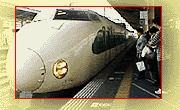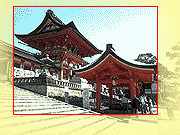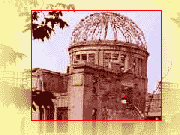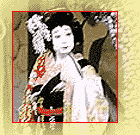 |
 |
 |
|
|||
|
Japan by Bullet I blame my upbringing. Raised in the North of England the birthplace of railways, how could I not love trains? And my fascination with Japan? Well that goes that far back too--to the time I wore a silly hat and ponytail wig in a school production of The Mikado. The chance to see Japan and by train was just too good to miss.
For under $250 you can buy a Japan Rail pass giving you a week's travel on most lines throughout Japan This is the way to go, relaxing in your reclining seat on the Shinkansen--the bullet train--at speeds of up to 160 miles an hour. We're heading west from Tokyo on one of the great railway journeys of the world My first stop is Kyoto, one-time capital of Japan, home to 2,000 temples and shrines. There are two main religions in Japan: Buddhism and Shintoism. In simple terms, Buddhism deals with the life hereafter, Shinto with the present. Most Japanese hedge their bets and go for both. You pray to Shinto deities for prosperity, to bless your marriage, even to bless your car to ensure safe driving! But you turn to Buddhism for funerals and worship of ancestors.
This is an amazing ceremony I stumbled across. The old priests are in white costumes wearing little shiny black caps that look like they're made from coffee jar lids. They have embroidered yokes round their necks with orange pom poms hanging from them. We're standing in front of a six foot high pile of sticks on which prayers are written. Singing and chanting, the priests set fire to them, releasing the prayers to heaven. After a day wandering round Kyoto's amazing gardens and temples it's time to head off to a Ryokin--a traditional Japanese inn, with tatami matting, a futon bed and communal hot bath. First you shower (you never get into a bath dirty in Japan even if you're on your own) and then it's time to climb into the water...the hot water.
The following day it's back on the train, heading west again, this time to a modern industrial city which, but for an event which happened over 50 years ago, would hold little interest for the modern visitor.
The A-bomb museum in Hiroshima is just a tram ride from the Shinkansen station. Here you see the results of that fateful night and hear the stories of survivors. Myoki Watanabe was 13 when the bomb dropped. Knocked unconscious by the blast, her first response on coming round was to look for her mother.
She gave her mother first aid, then went outside.
Back on the Shinkansen, it's time to return to Tokyo--a five-hour trip. I've got tickets for a Japanese show. But this is hardly Andrew Lloyd Webber.
This is traditional kabuki theater. Its origins lie in 17th century Japanese song and dance shows. But it seems back then they got a bit bawdy--the leading lady often doubled as a prostitute, so women were banned and the government decreed that men play all the parts instead. They still do today. With their painted faces, huge wigs and elaborate costumes they parade round the stage with majestic exaggerated movements--traitors, murderers and suicidal lovers. The orchestra sounds like a bunch of kindergarten kids playing home-made instruments and I haven't a clue what's going on, but the Japanese obviously think it's great fun. The audience seem to be older Japanese, so after the show I persuade some teenagers to let me join them in a more modern Japanese pastime--karaoke. A group of us are crammed into a small cubicle with a TV screen and microphone. It's awful. And soon I have to pay the price for being allowed to join them in this exercise in mutual abuse...by singing myself. Suddenly it dawns on me--I've come full circle. I've traveled all these miles and here I am again, in the land of the Mikado, a wandering minstrel...and no better than I was first time round! From Japan, this is Martin Stott, apologizing, for the Savvy Traveler.
|
 | American Public Media Home | Search | How to Listen ©2004 American Public Media | Terms of Use | Privacy Policy |




